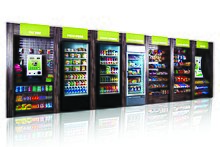This article contains promotional content. (July 2022) |
Micro Markets constitutes a retail sector closely associated with the vending machine industry.

They employ automated self-checkout technology and are commonly found in locations requiring unattended payment systems. Micro Markets offer grab-and-go retail environments where customers can purchase products from open shelves, coolers, and freezers.[1] Consumers use self-checkout kiosks for a streamlined experience.
Micro Markets resembles a modern convenience store but functions as a fusion of vending, foodservice, and refreshment services. They typically consist of open rack displays, refrigerated coolers or freezers, and self-checkout kiosks.
The National Automatic Merchandising Association (NAMA)[2] recognizes Micro Markets as a significant focus channel, along with vending, food service, and refreshment services.[2]
A typical Micro Market generally stocks between 150 and 400 products, a notable contrast to the standard vending machine's capacity of around 40 products.[3] In addition to product variety, open flow layouts and cashless payment options reduce waiting times, promote multiple-item purchases, and increase transaction values compared to cash transactions.[4]
Micro Markets are appealing to vending industry operators due to their potential profitability. According to a study by Micro Market provider Parlevel Systems, a Micro Market in a location with 125 employees can generate over $1,000 per week on average. Statistics also indicate that replacing vending machines with Micro Markets increases location sales by around 80%.[5] However, there are challenges such as theft associated with this technology.
Micro Market adoption has grown significantly due to the enhanced efficiency and convenience for consumers and operators. This growth has led to the replacement of banks of vending machines with Micro Markets. Since their inception in 2005,[2] Micro Markets have witnessed steady adoption, with substantial growth between 2012 and 2016.[6] During this period, active Micro Market locations increased by 574%, from 2,642 in 2012 to 17,806 in 2016.[6] Micro Market sales grew by 42% between 2015 and 2016,[6] accounting for 20% of total sales.[7] In 2016, total sales included 456 million consumer transactions and over 660 million product purchases.[6]
Micro Markets are typically placed in closed environments like office breakrooms with 150 to 500 employees. However, technological innovations like 365 Retail Markets' "nanomarket"™[8] are making Micro Markets viable in locations with fewer than 150 patrons. Locations with over 500 patrons benefit from the "grab-and-go" option appealing to a broader range of consumers.[9]
As per an assessment:
The next couple of years will clarify the overall size of the opportunity, but we expect it is actually more than double the initial 2013 projection of 33,500 [by 2022] [MicroMarket] sites and will ultimately deliver $4 billion[-]plus in channel sales.
— The Micro Market Channel—Proven and Strengthening, Automatic Merchandiser[9]
References
edit- ^ "StackPath". www.vendingmarketwatch.com. 15 September 2022. Retrieved 2022-09-27.
- ^ a b c Kasavana, Ph.D., NCE5, Michael; McVety, Jerry; Kasavana, MBA, Emily L. (2016). Mastering Micro Markets: An Operations Manual For Increasing Profitability In Micro Markets. NAMA. p. 1.
{{cite book}}: CS1 maint: multiple names: authors list (link) CS1 maint: numeric names: authors list (link) - ^ Ketzenberg, Michael E.; Geismar, Neil; Metters, Richard D.; van der Laan, Erwin A. (March 31, 2011). "The Value of Information for Managing Inventory in Vending Machines" (PDF). NAMA: 4.
- ^ Calkins, Erin. "What You Don't Know About Account Funding Could Be Costing You Thousands of Dollars in Fees". 365RetailMarkets.com. 365 Retail Markets. Retrieved October 29, 2014.
- ^ "Infographic: The Impact of Micro Markets". Parlevel Systems. 2017-03-08. Retrieved 2018-12-13.
- ^ a b c d Bachtelle, Brad (October 12, 2017). "The Micro Market Channel—Proven and Strengthening". Automatic Merchandiser (October/November): 23.
- ^ Zimmer, Adrienne (December 2016). "Micro Market Pulse: No Slowing Down in 2017". VendingMarketWatch.com. Vending Market Watch. Retrieved December 1, 2016.
- ^ "365 Retail Markets Launches Innovative nanomarketTM Kiosk". 365RetailMarkets.com. 365 Retail Markets. Retrieved April 4, 2017.
- ^ a b Bachtelle, Brad (October 12, 2017). "The Micro Market Channel—Proven and Strengthening". Automatic Merchandiser (October/November): 25.